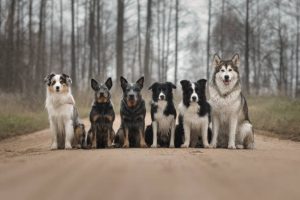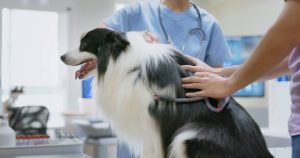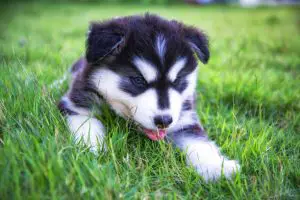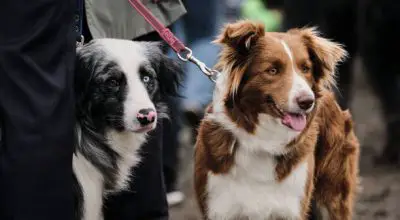Border Collies and Siberian Huskies are well-liked dog breeds yet require different care. These breeds are working dogs for various reasons: herding sheep and pulling sleds. While Siberian Huskies are fine with moderate exercise, Border Collies are energetic and require much more. Siberian Huskies are more autonomous and might be more challenging to teach, although Border Collies are also quite intelligent and require a lot of mental stimulation.
If you’re considering getting a dog, you should carefully consider which breed best fits your home and family. Beautiful as they are, Border Collies and Siberian Huskies have very distinct requirements from their owners. Please keep reading to find out the particulars of their contrast.
Characteristics Comparison between Border Collies and Siberian Huskies
Let’s start by comparing Border Collies and Siberian Huskies, two popular dog breeds. Neither breed is ideal for first-time or inexperienced pet owners. The Siberian Husky is the more pleasant, yet both are well with kids. A Border Collie requires less time and effort to keep clean than a Siberian Husky. Both types of dogs are known to be quite noisy.
The differences between Border Collies and Siberian Huskies are summarized in the following table.
| Characteristic | Border Collie | Siberian Husky |
|---|---|---|
| Origin | Scotland | Siberia |
| Temperament | Active, intelligent, and easily trained | Laid-back, independent, and friendly |
| Energy level | High | Moderate |
| Exercise needs | 2-3 hours per day | 1-2 hours per day |
| Grooming needs | Daily brushing | Weekly brushing |
| Shedding | Heavy | Moderate |
| Lifespan | 12-15 years | 12-15 years |
History of Breeds
The Border Collie is a breed of dog initially employed to herd sheep along the border between Scotland and England, where it was developed. According to certain historians, the species has been documented since the 1800s, and its lineage may go back even further. In 1915, James Reid, secretary of the International Sheep Dog Society, first used the name “Border Collie” to describe the breed.
Originating from the same canine lineage on the British Isles, the Border Collie and other collie breeds grew increasingly distinct as dog shows gained popularity and breed standards were established. The history of the Border Collie is intertwined with that of cattle production and the wool trade in early modern Britain and her colonies.
The ancestry of the Siberian Husky may be traced back more than 9,500 years; it shares genetic similarities with ancient Lake Baikal canines and historical East Siberian dogs. Several Arctic dogs, notably the Siberian, share a high genetic similarity with the extinct Taimyr wolf of North Asia.
Appearance of Siberian Huskies compared to a Border Collies

The size difference between a Siberian Husky and a Border Collie is not noticeable, although their looks and trainability are apparent. When compared to Huskies, Border Collies are significantly more amenable to training. Many Arctic dog breeds, including the Alaskan Malamute, share the wolf-like look of huskies.
To put it simply, Border Collies are far more manageable in size. Border Collies often have coats that are black and white. Border Collies are lovable because they are kind and adore human company.
Size
The size between Siberian Huskies and Border Collies has minimal variation. Border collies typically range from 30 to 55 pounds and 18 to 22 inches in height. A husky’s average height and weight are 23.5 inches and 35 pounds, respectively. On average, huskies may be a tad bigger than other dog breeds, but the difference is negligible.
Coats & Colors
Coat color and texture are two ways Siberian Huskies and Border Collies diverge. Black and white, gray and red, or sable and agouti are the coat colors for Siberian Huskies. Medium-sized dogs known as Border Collies have a double coat in multiple colors and patterns, from black and white to red and white to blue merle to sable merle.
Difference in Personality & Temperament
Although the Siberian Husky and the Border Collie are popular dog breeds, their personalities couldn’t be more dissimilar. It is commonly held that Siberian Huskies are friendlier than Border Collies. The American Temperament Test Society (ATTS) backs this up with its statistics on dogs’ reactions to different scenarios. Siberian Huskies have an ATTS score of 86.8 compared to 82.4 for Border Collies. This bodes well for the breed’s temperament, as a passing ATTS score indicates a healthy Siberian Husky.
Compared to Border Collies, Siberian Huskies may be more approachable for several reasons. For one thing, Siberian Huskies have always been bred to work in packs. This indicates that they have socialized well with both canine and human companions. On the other hand, Border Collies were purposely developed for herding. This means they are more capable of making decisions independently and may be less inclined to make friends easily.
In part, Siberian Huskies could be friendlier than Border Collies since they tend to be less active than the latter. There’s a stereotype that Siberian Huskies are couch potatoes. However, Border Collies require extensive physical activity due to their high energy levels. Border Collies are high-energy dogs, making them challenging for some people, especially those with young children.
It is commonly held that Siberian Huskies are friendlier than Border Collies. A Siberian Husky could be an excellent choice if you’re searching for a dog that’s patient with kids and generally outgoing.
Family of Border Collie vs Husky
Border Collies are typically calm and friendly pets. Young children running amok without supervision can be dangerous due to their boundless energy and natural herding drive. They may pinch, bark, push, and chase you, which is terrifying.
The Siberian Husky is a family-friendly dog. Huskies thrive when they are among humans and other dogs. They are also renowned for their unwavering devotion and love for their human companions.
Kids
Border Collies are typically calm and friendly pets. Young children running amok without supervision can be dangerous due to their boundless energy and natural herding drive. The BC may pinch, bark, push, and chase you, which is terrifying.
They thrive when they are among humans and other dogs. These dogs are also renowned for their unwavering devotion and love for their human companions.
Other People
Huskies do not have a reputation for hostility toward other animals or people. However, a Husky’s attitude toward other canines can vary from dog to dog and from experience to experience. It’s vital to get your Husky out on the right foot socially so it feels comfortable around new people. To help the dog feel more comfortable among people, consider having friends or willing strangers take him on brief leashed walks. Although some Huskies may exhibit attacks on small animals due to their high prey drive, this is not typical of the breed.
Obedience best describes the Border Collies. However, they can become violent when perceiving another dog as a threat. The Border Collie’s unwavering devotion is only reserved for one family member. Border Collies may show aggression toward outsiders when protecting their pack, home, and possessions or feeling threatened.
Dogs & Other Animals

Huskies are generally friendly dogs and can get along well with other dogs and animals if socialized from a young age. However, Huskies can be aggressive towards other dogs if that dog is small and fluffy. This is because Huskies have a strong prey drive which can lead them to attack small animals.
They are generally friendly; however, they can be aggressive with other dogs. This trait manifests itself only in the presence of the person to whom the Border Collie is most devoted. When protecting their pack or their belongings, or when feeling threatened, Border Collies may resort to aggressive behavior toward outsiders.
Behaviour Issues
Problematic behaviors in Huskies and Border Collies are distinct. If another dog is small and fluffy, a husky may attack it. Huskies have a high prey drive and may feel compelled to hunt and kill tiny creatures.
However, Border Collies can be extremely hostile when confronted by other dogs they view as threatening. The Border Collie’s unwavering devotion is only reserved for one family member. Border Collies may show aggression toward outsiders when protecting their pack, home, and possessions or feeling threatened.
Training & Exercise of a Border Collie and Siberian Husky
High-energy canines like Border Collies and Siberian Huskies need regular physical and mental activity. Border Collies are well-liked because of their trainability and the fact that they are intelligent and eager to please their owners. They are high-energy pets that need regular playtime and mental challenges.
Border Collies retain their innate herding instinct because of their ancestry and breeding. It’s crucial to start training them young so they don’t try to herd people or other animals. Because of their high intelligence and susceptibility to boredom, Border Collies require frequent opportunities for mental exercise. Games, puzzles, and practice sessions are all good options for this.
Siberian Huskies are high-energy canines that benefit from regular playtime and mental challenges. Their passion for running has earned them a reputation for toughness. A solid need to run persists in the breed of dog developed initially to pull sleds in the Arctic. They need much room to play and run around, so apartment life is not ideal. As sociable canines, Siberian Huskies thrive when given frequent opportunities to socialize with their human companions.
If you’re considering getting one of these breeds, you should know they require a lot of exercise and mental stimulation.
Taking Care & Maintenance Difference
Border collies and huskies need a lot of exercise, mental stimulation, and human companionship. Both species require early and consistent socialization to thrive. From an early age, expose children to a wide range of people, animals, and settings. This helps kids develop a sense of independence and confidence in various locations. Enroll them in puppy classes or obedience training to socialize with other dogs and humans.
Ensure your dog sees the vet often to ensure their health. Follow your vet’s instructions for administering vaccines, flea and tick prevention, and heartworm medicine. Changes in appetite, behavior, or bathroom habits could indicate illness, so it’s essential to keep an eye out for them regularly.
The friendship and love of humans are essential to the well-being of both Border Collies and Huskies. Give your dog lots of affection by spending time with it. This will improve your relationship with them and their quality of life.
Keep in mind that every dog is an individual with specific requirements for care. The best care you can give your dog will come from observing and learning about their habits and preferences.
Grooming of Siberian Husky and Border Collie
The long, coarse outer skin and the short, dense undercoat of a Border Collie are double-coated. The dog’s coat functions in two ways: the outer coat keeps the dog dry, and the undercoat keeps the dog warm. Daily brushing is essential during the two times a year when Border Collies shed extensively to avoid mats and tangles. The natural oils in their coat are spread out and kept healthy and lustrous by regular brushing. Bathing your Border Collie once every couple of weeks is recommended, or more often if they get dirty or smelly.
Meanwhile, the Siberian Husky’s outer coat is shorter and finer, even if they are also double-coated. They have a thicker undercoat that serves to insulate them from the cold. Although shedding occurs year-round for Siberian Huskies, it is most noticeable in the spring and fall. Brushing them daily during the shedding season is recommended to avoid mats and tangles, just as it is for Border Collies. The natural oils in their coat are spread out and kept healthy and lustrous by regular brushing. Siberian Huskies need a bath every few weeks or more often if they are unclean or smelly.
Border Collies and Siberian Huskies benefit from having their nails clipped regularly in addition to combing and bathing. It is also essential to keep their ears clean to avoid infections. Consult a professional groomer if you are unclear on how to care for your dog’s coat.
Shedding
Border Collies and Siberian Huskies are similar in undergoing seasonal shedding. Brush your dog more often during the shedding season to eliminate loose hair. Border Collies have two major shedding seasons a year because of their double coat—the double coat of a Siberian Husky results in significant twice-yearly shedding.
Life Span
Both Border Collies and Siberian Huskies are estimated to live for 12-15 years on average. Although some dogs of either breed may live longer or shorter than the average, this is often the case.
When compared to Siberian Huskies, the average lifespan of a Border Collie is significantly greater. The typical lifespan of a Border Collie is 13.5 years. Their strong genes and careful breeding efforts have contributed to their generally healthy appearance.
On the other hand, a Siberian Husky can expect to live between 12 and 15 years. It’s worth noting, though, that individual dogs within a breed can have their lives shortened by inherited health problems.
Diet & Nutrition
The Siberian Husky requires a well-rounded diet that considers its age, activity level, and calorie requirements. Protein, healthy fats, vitamins, minerals, fiber, and fruit and vegetable sources are standard components of such a diet. The Border Collie Husky cross requires a high-protein, high-fat diet. A high-quality dry food and a raw diet will work for this breed.
Health Issues

Although both Siberian Huskies and Border Collies are generally healthy, they are susceptible to the same canine ailments as any other breed. The following are some of the most typical health problems in each species:
Siberian Huskies:
- Hip dysplasia – a genetic disorder characterized by abnormal hip joint development, resulting in pain and disability.
- Progressive Retinal Atrophy (PRA) – is a degenerative eye disease that causes gradual vision loss and blindness.
- Cataracts – cause the eye’s lens to become cloudy or opacified, impairing vision.
- Hypothyroidism – an insufficient hormone production by the thyroid gland that causes various symptoms, including hunger, fatigue, and skin issues.
- Exertion Induced Collapse (EIC) – is a genetic abnormality that causes muscles to weaken or collapse after vigorous exercise or emotional stimulation.
Border Collies:
- Collie Eye Anomaly (CEA) – a genetic eye illness that causes severe visual impairment or blindness.
- Hip dysplasia – Border Collies, like Huskies, may suffer from hip dysplasia.
- Epilepsy – Seizures are the hallmark symptom of epilepsy, a neurological condition. Epilepsy is more common in Border Collies than in other dog breeds.
- Progressive Retinal Atrophy (PRA) – Border Collies are not immune to PRA, a degenerative eye disease that can lead to blindness if left untreated.
Anesthesia and other drugs Border Collies may be genetically sensitive should be discussed with veterinarians before any necessary medical treatments.
It’s worth stressing that not all dogs will experience these health problems and that the likelihood of them occurring can be decreased by careful breeding. Siberian Huskies and Border Collies can benefit from frequent veterinary checkups, a balanced diet, plenty of exercise, and other preventative measures.
Cost of Getting a Husky vs. Border Collie
The price of a Husky or Border Collie can range from a few hundred to several thousand dollars, depending on the breeder’s location, the dog’s age, and the dog’s pedigree. A Border Collie will run you anything from $600 to $1,200, while a Husky will set you back anywhere from $1,000 to $2,000. It’s worth noting that breeder and location can significantly affect these costs.
Puppies of Husky vs. Border Collie

Puppies of both the Husky and the Border Collie tend to be regarded as particularly cute. There are, however, notable distinctions between the two species. A Border Collie litter typically has between 6 and 8 puppies, while a Husky litter typically has between 4 and 6 puppies. It’s worth noting that these figures may change from dog to dog.
Breeders & Centers
If you have concluded that a Border Collie or Siberian Husky is the right breed, you should start looking for a breeder. Border Collie and Siberian Husky breeders in your area are excellent resources for information and referrals to trustworthy breeders in your area. If none of those options work, you can always ask other members of breed-specific Facebook groups if they know of any good breeders.
Border Collies and Siberian Huskies are frequently abandoned at shelters because their potential owners didn’t care enough for the breed’s unique needs, such as the required daily activity. This is why many Border Collies and Siberian Huskies end up in rescue centers.
The ideal place to start looking for a Border Collie or Siberian Husky to rescue would be your local rescue shelter, but you should also check with local specific breed centers. The Border Collies of America and the Siberian Husky Club of America provide state-by-state rescue organization listings.
Conclusion: Which Is Better, Siberian Husky or Border Collie?
It is impossible to give a universally correct answer as to which dog is superior, the Siberian Husky or the Border Collie. Different people may find the distinct attributes and characteristics of each species appealing. High-energy dogs like Siberian Huskies and Border Collies, for instance, need regular physical and mental activity.
Both types can be suitable companions for people who lead active lives and like doing things like running and hiking. However, Border Collies may need even more rigorous mental stimulation and training to channel their boundless energy than other high-energy dog breeds.
Which breed is “better” depends on your preferences, living situation, and capacity to provide for the breed’s unique requirements. Although Siberian Huskies and Border Collies can make excellent pets, they need consistent training, exercise, mental stimulation, and socialization to reach their full potential as companion animals. You should learn as much as possible about both breeds and spend time with each to see which best suits your needs and preferences.



